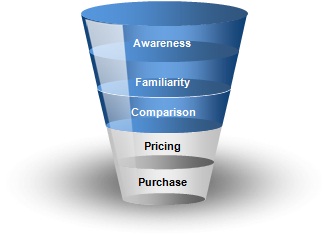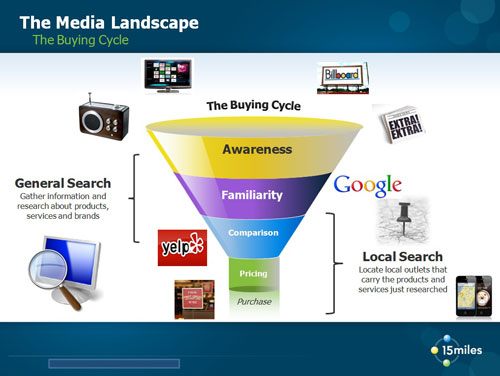Death of the Website as a Marketing Tool?
Best practices for developing a "full funnel" marketing plan.
Best practices for developing a "full funnel" marketing plan.
Small and large brands today often ask about the company website’s relevance and importance. At one time, the website served as the foundation of all online marketing efforts. With the rise in importance of social platforms like Facebook, some now wonder: how important is the company website? Since Google Place Pages now dominate the top search positions, many also question whether they should abandon their SEO efforts aimed at elevating search positions for the website.
The website’s role has changed – and it hinges on what stage of the purchase process, where and when, a consumer enters a site. Today, directional navigation and conversion optimization have become important. Customers and prospects take many differing paths to purchase, so a diversified, distributed, and integrated approach must be developed to maximize lead and sales volume.

For example, a consumer who has already decided she wants to purchase a widget from Acme Widgets may navigate to the site simply to find the closest location and store hours; we’d assign her to the “purchase” stage of the funnel. The most important thing for people like her is the store locator, access to local location pages, or Google Places. However, a consumer looking to compare Acme Widgets’ new “left-handed smoke shifter” to Spacely Sprockets’ “smoke diverter” is in the “comparison” stage and needs access to detailed product information, purchaser reviews, or shopping engines like NexTag. Now you start to see the pattern. The consumer’s information needs have not changed; it is where the consumer is accessing the information that is important and more diversified.
The lesson? Now, more than ever, websites must become vessels of content that can be distributed across numerous platforms so that consumers working through the purchase process can access the information where they are seeking a personalized solution.
Building a Full Funnel Marketing Plan
Begin with an audit of all marketing and media vehicles that you are using. Much like building an editorial or messaging calendar, map your customers’ information needs and label them by which stage in the sales/purchase process they cover. This exercise can be tricky because many marketing vehicles do not solely cover one purpose. For example, display advertising can be used as a top-of-the-funnel vehicle, serving to build “awareness” for your brand or business and retargeting can serve as a direct response “purchase” vehicle. In these cases, break down individual campaigns and discretely assign them to their main or primary purpose.
Once the campaigns and marketing elements are mapped, identify areas where you do not have content that addresses a particular stage in the purchase process. Keep in mind that each stage of the purchase process is important and works in an integrated fashion. I’ve had major national brands that were spending millions of marketing dollars on branding and “awareness” campaigns question why direct response vehicles like search and e-commerce shopping programs decreased in effectiveness when they paused their branding spending. It’s difficult to assign a one-to-one relationship to the various funnel activities; e.g., a dollar in “branding” spend results in x dollars in purchases. All elements have an impact (positive or negative) and need to be stitched together in a comprehensive marketing plan and measurement program. Once this task is completed, you can get better insight into assigning attribution weights to the various elements. Now armed with your “funnel stage” audit, you can identify gaps and develop or redevelop content to cover these holes.
Back to your website. Understanding that consumers will access your site via numerous connections (paid listings, promotions, social platforms, etc.) and that these connections are now assigned to differing stages in the purchase process – are they joined to the correct website content based on their stage? One missed opportunity we see from most advertisers is the common practice of linking most or all content to the home page of their website, regardless of the specificity of the inbound link. In search marketing campaigns, the correct practice is “deep linking” or aligning landing content to the explicit keyword purpose or intent. For example, land a consumer in the e-commerce section if a keyword is combined with “buy” as part of the string or in the comparison section if the keyword string where “Brand A vs. Brand B.”

Now back to your funnel audit, is your content in all the places where consumers seek out the differing purchase stage content? Having the website content tuned is good, but you need to ensure that you take a distributed approach so the content also exists where consumers are interacting with it. Conduct an advertising, business profile, and listing reach audit to make sure you have prioritized their most popular access points and that the content is aligned to their purchase stage. An example here is that a business profile of a comparison directory such as Yelp should contain lower funnel comparison and perhaps pricing information and be joined directly to purchase points (telephone, online purchase form, etc.) versus your Chamber of Commerce listing, which should contain more generalized content about your brand, years in business, etc., to establish credibility.
So is the website dead as a marketing method? No, but a website is not the sole content location that consumers use when making purchase decisions. A diversified, distributed, and integrated plan that takes advantage of the entire purchase funnel is the best way to go. Full funnel marketing is hard and detail oriented. But once its lessons are unlocked, the spoils of cost-effective sales leads are the reward.